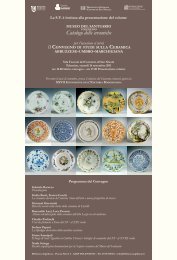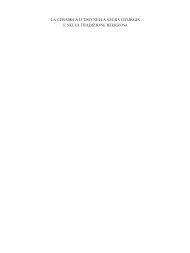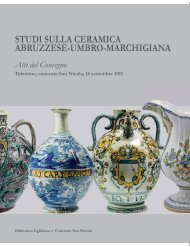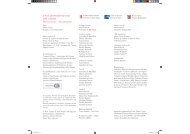Le maioliche rinascimentali nelle collezioni della ... - Claudio Paolinelli
Le maioliche rinascimentali nelle collezioni della ... - Claudio Paolinelli
Le maioliche rinascimentali nelle collezioni della ... - Claudio Paolinelli
You also want an ePaper? Increase the reach of your titles
YUMPU automatically turns print PDFs into web optimized ePapers that Google loves.
136 Plate with a putto riding a griffin.<br />
Duchy of Urbino, c1525.<br />
In the centre of the plate is a roundel with a winged putto<br />
riding a griffin, which faces stylized grass-covered rocks. The<br />
figures stand out against a deep blue ground. A broad white<br />
band with symbols arranged around it on the sides of the well<br />
separates the central scene from the broad rim, which has<br />
trophies with cornucopias alternating with flowering scrolls.<br />
The reverse is decorated in blue, divided into six by radiating<br />
wavy lines with crossed bulb motifs between them. In the<br />
centre is a cross formed of multiple parallel lines. The colours<br />
are blue, green, yellow, and orange-brown.<br />
This is an exceptional object in its decoration and in the band<br />
of graphic symbols, to which no parallel has been found from<br />
the known production centres. It was probably made in one<br />
of the lesser-known pottery-producing towns in <strong>Le</strong> Marche 1 .<br />
The attribution made by von Falke 2 to Castel Durante 3 , or at<br />
least to the Duchy of Urbino, has recently been re-proposed 4 .<br />
Nonetheless it is important to realise that this exceptional plate<br />
has a direct relationship to a number of objects with the same<br />
decorative language, especially in the arrangement of the<br />
border decoration divided into eight sections in fourfold symmetry.<br />
Comparison may be made with a plate in the Victoria<br />
& Albert Museum, London 5 , and with one in the Civic Museums<br />
of Pesaro 6 . Both arrange the rim in a way that has<br />
similarities, incorporating into eight sections cornucopias and<br />
plant motifs in alternation. Specifically, the corpulent blond<br />
putti that stand out against the deep blue of the ground in the<br />
centre of the plate in Pesaro offer further points of comparison.<br />
It seems that the mixture of cultural elements which<br />
influenced the taste of some potters from the River Metauro<br />
region in the first quarter of the sixteenth century 7 was in<br />
some degree adopted by Umbrian culture, mediated by the<br />
experience of Gubbio 8 ; the outcome was large Deruta display<br />
plates in which “the rim is broad and flanged at the edge and<br />
its decoration is independent of the centre, for which it in a<br />
certain sense provides a frame” 9 . The central decoration with<br />
the winged putto riding a griffin has hitherto been associated<br />
with allegorical representations in medieval bestiaries 10 or alternatively,<br />
in a challenging reading, as a personification of a<br />
particular person such as the Duke of Urbino himself 11 . Sometimes,<br />
however, this sort of subject is simply ornamental, bringing<br />
together monstrous creatures like hippocamps, dragons or<br />
wild beasts, with playing children 12 .<br />
To emphasize the central roundel, the sides of the well have<br />
a series of graphic symbols which give the plate a quality of<br />
mystery and have given rise to several attempts at interpretation<br />
13 . Although a recent study attempts to link these signs<br />
with Duke Francesco Maria I Della Rovere 14 , a more likely<br />
interpretation would seem to be to read them as a composition<br />
in Hebrew characters. Dr Ennio Napolitano of the “Orientale”<br />
University of Naples has succeeded in providing a plausible<br />
interpretation as follows:<br />
“On the plate are twenty-four letters of the Hebrew alphabet<br />
repeated as follows:<br />
eight alef (!), eight lamed (-), six dalet (9), and two samekh<br />
(2).<br />
If we consider each letter in relation to the one opposite it we<br />
have four groups of six letters arranged mirror fashion. These<br />
four groups in reality form four stars of David as follows (the<br />
425








